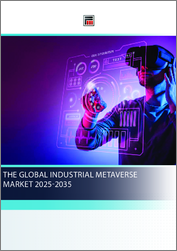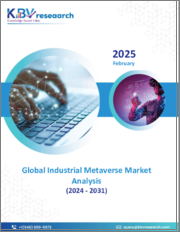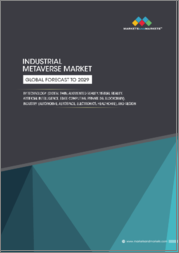
|
시장보고서
상품코드
1801283
세계의 산업용 메타버스 시장 : 산업 분석, 시장 규모, 점유율, 성장, 동향, 예측(2025-2032년)Industrial Metaverse Market: Global Industry Analysis, Size, Share, Growth, Trends, and Forecast, 2025 - 2032 |
||||||
Persistence Market Research는 전 세계 산업용 메타버스 시장에 대한 종합적인 분석을 발표했습니다. 본 보고서에서는 시장촉진요인, 동향, 기회, 과제 등의 중요한 시장 역학을 철저히 평가하여 시장 구조에 대한 상세한 통찰을 제공합니다.
주요 인사이트
- 산업용 메타버스 시장 규모(2025년) : 253억 달러
- 시장 규모 예측(금액 기준, 2032년) : 1,241억 달러
- 세계 시장의 성장률(CAGR 2025-2032년) : 25.5%
산업용 메타버스 시장 - 분석 범위
산업용 메타버스는 디지털 트윈 기술, IoT, 증강현실(XR), 인공지능(AI)의 융합을 의미하며, 제조, 엔지니어링, 물류 및 에너지 분야에서 실시간 몰입형 시뮬레이션 및 협업을 가능하게 합니다. 보다 스마트한 의사결정, 예지보전, 근로자 교육, 가상 프로토타이핑을 촉진하여 업무 효율성과 혁신 파이프라인을 변화시킵니다. 이 시장은 디지털 산업용도를 위해 조정된 소프트웨어 플랫폼, 하드웨어 인프라 및 서비스 에코시스템을 포함합니다.
시장 성장 촉진요인:
세계 산업용 메타버스 시장은 인더스트리 4.0 원칙의 채택 증가, 원격 협업 도구 수요, 생산 환경에서의 첨단 시뮬레이션 및 시각화 요구 증가 등 여러 요인에 의해 추진되고 있습니다. 디지털 트윈과 AI 및 XR의 통합은 다운타임을 줄이고 자산 이용률을 향상시키는 실시간 모니터링 및 예측 기능을 제공합니다. 위험한 산업 환경에서 지속가능성, 비용 효율성, 근로자의 안전성을 강조하는 경향이 강해지고 있으며 시장 도입이 더욱 가속화되고 있습니다. 또한 COVID-19의 대유행은 디지털 전환에 대한 관심을 증폭시켜 메타버스 관련 인프라에 대한 투자를 가속화하고 있습니다.
시장 성장 억제요인 :
견고한 성장 가능성에도 불구하고 산업용 메타버스 시장은 데이터 프라이버시, 상호 운용성, 고가의 초기 비용과 관련된 과제에 직면하고 있습니다. 산업 조직은 종종 레거시 시스템과 최신 메타버스 플랫폼의 통합에 어려움을 겪고 있으며 본격적인 배포가 제한됩니다. 보안 취약점과 몰입형 데이터 교환을 위한 표준화된 프로토콜의 부족은 산업 환경을 사이버 위험에 노출시킬 수 있습니다. 또한 디지털 트윈 제작의 복잡성과 XR 및 AI 분야의 인력 부족은 메타버스 솔루션의 도입을 목표로 하는 기업에 운영상의 제약을 가져옵니다.
시장 기회 :
산업용 메타버스 시장은 클라우드 컴퓨팅, 5G 커넥티비티, AI 주도 애널리틱스의 융합이 진행됨에 따라 큰 성장 기회를 가져오고 있습니다. 산업 교육, 공급망 투명성, 실시간 협업의 새로운 이용 사례는 중요한 가치 제안을 창출합니다. 메타버스 플랫폼 제공업체와 산업 선도자 간의 파트너십은 새로운 수익원을 확보하고 프로세스 자동화 및 설계 검증의 혁신을 촉진하고 있습니다. AR/VR 하드웨어 기능의 확대와 IoT 센서의 비용 저하는 보급을 더욱 촉진합니다. 스마트 공장과 디지털 인프라에 투자하는 정부와 기업은 세계 산업용 메타버스 에코시스템을 선도하는 태세를 갖추고 있습니다.
이 보고서에서 답변을 얻을 수 있는 주요 질문
- 세계 산업용 메타버스 시장의 성장을 가속하는 주요 요인은?
- 산업용 메타버스의 이용 사례의 급속한 진화에 공헌하고 있는 기술과 활용 영역은 무엇인가?
- 디지털 트윈 플랫폼과 XR은 산업 운영과 인재 육성을 어떻게 재구성하고 있는가?
- 산업용 메타버스 시장에 기여하는 주요 기업은 누구이며 시장의 리더십을 유지하기 위해 어떤 전략을 채택하고 있는가?
- 세계의 산업용 메타버스 시장에서의 새로운 동향과 장래성은?
목차
제1장 주요 요약
제2장 시장 개요
- 시장의 범위와 정의
- 밸류체인 분석
- 거시경제 요인
- 세계의 GDP 전망
- 세계의 경제 성장 예측
- 세계의 도시화의 진전
- 기타 거시 경제 요인
- 예측 요인 : 관련성과 영향
- COVID-19의 영향 평가
- PESTLE 분석
- Porter's Five Forces 분석
- 지정학적 긴장 : 시장에 미치는 영향
- 규제와 기술의 상황
제3장 시장 역학
- 성장 촉진요인
- 억제요인
- 기회
- 동향
제4장 가격 동향 분석(2019-2032년)
- 지역별 가격 분석
- 부문별 가격
- 가격의 영향요인
제5장 세계의 산업용 메타버스 시장 전망 : 과거(2019-2024년)와 예측(2025-2032년)
- 주요 하이라이트
- 세계의 산업용 메타버스 시장 전망 : 기술별
- 소개/주요 분석 결과
- 과거 시장 규모 실적 : 기술별(금액 기준, 2019-2024년)
- 현재 시장 규모 예측 : 기술별(금액 기준, 2025-2032년)
- 가상현실(VR)
- 증강현실(AR)
- 복합현실(MR)
- 시장 매력 분석 : 기술별
- 세계의 산업용 메타버스 시장 전망 : 용도별
- 소개/주요 분석 결과
- 과거 시장 규모 실적 : 용도별(금액 기준, 2019-2024년)
- 현재 시장 규모 예측 : 용도별(금액 기준, 2025-2032년)
- 트레이닝 및 시뮬레이션
- 원격 협업
- 제품 설계 및 개발
- 자산운용 관리
- 공급망 관리
- 고객 서비스
- 제조업
- 물류
- 의료
- 교육
- 시장 매력 분석 : 용도별
제6장 세계의 산업용 메타버스 시장 전망 : 지역별
- 주요 하이라이트
- 과거 시장 규모 분석 : 지역별(금액 기준, 2019-2024년)
- 현재 시장 규모 예측 : 지역별(금액 기준, 2025-2032년)
- 북미
- 유럽
- 동아시아
- 남아시아 및 오세아니아
- 라틴아메리카
- 중동 및 아프리카
- 시장 매력 분석 : 지역별
제7장 북미의 산업용 메타버스 시장 전망 : 과거(2019-2024년)와 예측(2025-2032년)
제8장 유럽의 산업용 메타버스 시장 전망 : 과거(2019-2024년)와 예측(2025-2032년)
제9장 동아시아의 산업용 메타버스 시장 전망 : 과거(2019-2024년)와 예측(2025-2032년)
제10장 남아시아 및 오세아니아의 산업용 메타버스 시장 전망 : 과거(2019-2024년)와 예측(2025-2032년)
제11장 라틴아메리카의 산업용 메타버스 시장 전망 : 과거(2019-2024년)와 예측(2025-2032년)
제12장 중동 및 아프리카의 산업용 메타버스 시장 전망 : 과거(2019-2024년)와 예측(2025-2032년)
제13장 경쟁 구도
- 시장 점유율 분석, 2025년
- 시장 구조
- 경쟁 강도 매핑
- 경쟁 대시보드
- 기업 프로파일
- Microsoft
- Meta
- Unity Software
- Epic Games
- NVIDIA
- HTC
- Sony
- Magic Leap
- Apple
제14장 부록
- 분석 방법
- 분석의 전제
- 두자어 및 약어
Persistence Market Research has recently released a comprehensive report on the worldwide market for Industrial Metaverse. The report offers a thorough assessment of crucial market dynamics, including drivers, trends, opportunities, and challenges, providing detailed insights into the market structure.
Key Insights:
- Industrial Metaverse Market Size (2025E): USD 25.3 Billion
- Projected Market Value (2032F): USD 124.1 Billion
- Global Market Growth Rate (CAGR 2025 to 2032): 25.5%
Industrial Metaverse Market - Report Scope:
The industrial metaverse represents a convergence of digital twin technologies, IoT, extended reality (XR), and artificial intelligence (AI), enabling real-time, immersive simulations and collaboration in manufacturing, engineering, logistics, and energy sectors. It facilitates smarter decision-making, predictive maintenance, workforce training, and virtual prototyping, transforming operational efficiency and innovation pipelines. The market encompasses software platforms, hardware infrastructure, and service ecosystems tailored for digital industrial applications.
Market Growth Drivers:
The global industrial metaverse market is propelled by multiple factors, including the increasing adoption of Industry 4.0 principles, the demand for remote collaboration tools, and the rising need for advanced simulation and visualization in production environments. Integration of digital twins with AI and XR provides real-time monitoring and predictive capabilities that reduce downtime and improve asset utilization. The growing emphasis on sustainability, cost-efficiency, and worker safety in hazardous industrial settings further accelerates market adoption. Furthermore, the COVID-19 pandemic amplified interest in digital transformation, accelerating investments in metaverse-related infrastructure.
Market Restraints:
Despite robust growth potential, the industrial metaverse market faces challenges related to data privacy, interoperability, and high upfront costs. Industrial organizations often struggle with integrating legacy systems with modern metaverse platforms, limiting full-scale deployment. Security vulnerabilities and lack of standardized protocols for immersive data exchange can expose industrial environments to cyber risks. Additionally, the complexity of digital twin creation and talent shortages in XR and AI fields pose operational constraints for enterprises aiming to implement metaverse solutions.
Market Opportunities:
The industrial metaverse market presents vast growth opportunities, driven by the increasing convergence of cloud computing, 5G connectivity, and AI-driven analytics. Emerging use cases in industrial training, supply chain transparency, and real-time collaboration create significant value propositions. Partnerships between metaverse platform providers and industrial giants are unlocking novel revenue streams and driving innovation in process automation and design validation. The expansion of AR/VR hardware capabilities and decreasing costs of IoT sensors further catalyze widespread adoption. Governments and enterprises investing in smart factories and digital infrastructure are poised to lead in the global industrial metaverse ecosystem.
Key Questions Answered in the Report:
- What are the primary factors driving the growth of the industrial metaverse market globally?
- Which technologies and applications are contributing to the rapid evolution of industrial metaverse use cases?
- How are digital twin platforms and XR reshaping industrial operations and workforce training?
- Who are the key players contributing to the industrial metaverse market, and what strategies are they employing to maintain market leadership?
- What are the emerging trends and future prospects in the global industrial metaverse market?
Competitive Intelligence and Business Strategy:
Leading players in the global industrial metaverse market, including Siemens AG, NVIDIA Corporation, Microsoft Corporation, and Hexagon AB, focus on technological innovation, ecosystem partnerships, and platform scalability to gain a competitive edge. These companies invest in R&D to develop interoperable digital twin frameworks, real-time 3D rendering solutions, and XR training environments for industrial use. Collaborations with manufacturing firms, robotics companies, and cloud service providers facilitate ecosystem expansion and accelerate market penetration. Emphasis on standardization, cybersecurity, and user-centric design enhances trust and usability in the evolving industrial metaverse landscape.
Key Companies Profiled:
- Microsoft
- Meta
- Unity Software
- Epic Games
- NVIDIA
- HTC
- Sony
- Magic Leap
- Apple
Industrial Metaverse Market Research Segmentation:
By Technology:
- Virtual reality (VR)
- Augmented reality (AR)
- Mixed reality (MR)
By Application:
- Training and Simulation
- Remote Collaboration
- Product Design and Development
- Asset Management
- Supply Chain Management
- Customer Service
- Manufacturing
- Logistics
- Healthcare
- Education
By Region:
- North America
- Latin America
- Europe
- Asia Pacific
- Middle East and Africa
Table of Contents
1. Executive Summary
- 1.1. Global Industrial Metaverse Market Snapshot 2025 and 2032
- 1.2. Market Opportunity Assessment, 2025-2032, US$ Mn
- 1.3. Key Market Trends
- 1.4. Industry Developments and Key Market Events
- 1.5. Demand Side and Supply Side Analysis
- 1.6. PMR Analysis and Recommendations
2. Market Overview
- 2.1. Market Scope and Definitions
- 2.2. Value Chain Analysis
- 2.3. Macro-Economic Factors
- 2.3.1. Global GDP Outlook
- 2.3.2. Global GDP Outlook
- 2.3.3. Global economic Growth Forecast
- 2.3.4. Global Urbanization Growth
- 2.3.5. Other Macro-economic Factors
- 2.4. Forecast Factors - Relevance and Impact
- 2.5. COVID-19 Impact Assessment
- 2.6. PESTLE Analysis
- 2.7. Porter's Five Forces Analysis
- 2.8. Geopolitical Tensions: Market Impact
- 2.9. Regulatory and Technology Landscape
3. Market Dynamics
- 3.1. Drivers
- 3.2. Restraints
- 3.3. Opportunities
- 3.4. Trends
4. Price Trend Analysis, 2019-2032
- 4.1. Region-wise Price Analysis
- 4.2. Price by Segments
- 4.3. Price Impact Factors
5. Global Industrial Metaverse Market Outlook: Historical (2019-2024) and Forecast (2025-2032)
- 5.1. Key Highlights
- 5.2. Global Industrial Metaverse Market Outlook: Technology
- 5.2.1. Introduction/Key Findings
- 5.2.2. Historical Market Size (US$ Mn) Analysis by Technology, 2019-2024
- 5.2.3. Current Market Size (US$ Mn) Forecast, by Technology, 2025-2032
- 5.2.3.1. Virtual reality (VR)
- 5.2.3.2. Augmented reality (AR)
- 5.2.3.3. Mixed reality (MR)
- 5.2.4. Market Attractiveness Analysis: Technology
- 5.3. Global Industrial Metaverse Market Outlook: Application
- 5.3.1. Introduction/Key Findings
- 5.3.2. Historical Market Size (US$ Mn) Analysis by Application, 2019-2024
- 5.3.3. Current Market Size (US$ Mn) Forecast, by Application, 2025-2032
- 5.3.3.1. Training and Simulation
- 5.3.3.2. Remote Collaboration
- 5.3.3.3. Product Design and Development
- 5.3.3.4. Asset Management
- 5.3.3.5. Supply Chain Management
- 5.3.3.6. Customer Servic
- 5.3.3.7. Manufacturing
- 5.3.3.8. Logistics
- 5.3.3.9. Healthcare
- 5.3.3.10. Education
- 5.3.4. Market Attractiveness Analysis: Application
6. Global Industrial Metaverse Market Outlook: Region
- 6.1. Key Highlights
- 6.2. Historical Market Size (US$ Mn) Analysis by Region, 2019-2024
- 6.3. Current Market Size (US$ Mn) Forecast, by Region, 2025-2032
- 6.3.1. North America
- 6.3.2. Europe
- 6.3.3. East Asia
- 6.3.4. South Asia & Oceania
- 6.3.5. Latin America
- 6.3.6. Middle East & Africa
- 6.4. Market Attractiveness Analysis: Region
7. North America Industrial Metaverse Market Outlook: Historical (2019-2024) and Forecast (2025-2032)
- 7.1. Key Highlights
- 7.2. Pricing Analysis
- 7.3. North America Market Size (US$ Mn) Forecast, by Country, 2025-2032
- 7.3.1. U.S.
- 7.3.2. Canada
- 7.4. North America Market Size (US$ Mn) Forecast, by Technology, 2025-2032
- 7.4.1. Virtual reality (VR)
- 7.4.2. Augmented reality (AR)
- 7.4.3. Mixed reality (MR)
- 7.5. North America Market Size (US$ Mn) Forecast, by Application, 2025-2032
- 7.5.1. Training and Simulation
- 7.5.2. Remote Collaboration
- 7.5.3. Product Design and Development
- 7.5.4. Asset Management
- 7.5.5. Supply Chain Management
- 7.5.6. Customer Servic
- 7.5.7. Manufacturing
- 7.5.8. Logistics
- 7.5.9. Healthcare
- 7.5.10. Education
8. Europe Industrial Metaverse Market Outlook: Historical (2019-2024) and Forecast (2025-2032)
- 8.1. Key Highlights
- 8.2. Pricing Analysis
- 8.3. Europe Market Size (US$ Mn) Forecast, by Country, 2025-2032
- 8.3.1. Germany
- 8.3.2. Italy
- 8.3.3. France
- 8.3.4. U.K.
- 8.3.5. Spain
- 8.3.6. Russia
- 8.3.7. Rest of Europe
- 8.4. Europe Market Size (US$ Mn) Forecast, by Technology, 2025-2032
- 8.4.1. Virtual reality (VR)
- 8.4.2. Augmented reality (AR)
- 8.4.3. Mixed reality (MR)
- 8.5. Europe Market Size (US$ Mn) Forecast, by Application, 2025-2032
- 8.5.1. Training and Simulation
- 8.5.2. Remote Collaboration
- 8.5.3. Product Design and Development
- 8.5.4. Asset Management
- 8.5.5. Supply Chain Management
- 8.5.6. Customer Servic
- 8.5.7. Manufacturing
- 8.5.8. Logistics
- 8.5.9. Healthcare
- 8.5.10. Education
9. East Asia Industrial Metaverse Market Outlook: Historical (2019-2024) and Forecast (2025-2032)
- 9.1. Key Highlights
- 9.2. Pricing Analysis
- 9.3. East Asia Market Size (US$ Mn) Forecast, by Country, 2025-2032
- 9.3.1. China
- 9.3.2. Japan
- 9.3.3. South Korea
- 9.4. East Asia Market Size (US$ Mn) Forecast, by Technology, 2025-2032
- 9.4.1. Virtual reality (VR)
- 9.4.2. Augmented reality (AR)
- 9.4.3. Mixed reality (MR)
- 9.5. East Asia Market Size (US$ Mn) Forecast, by Application, 2025-2032
- 9.5.1. Training and Simulation
- 9.5.2. Remote Collaboration
- 9.5.3. Product Design and Development
- 9.5.4. Asset Management
- 9.5.5. Supply Chain Management
- 9.5.6. Customer Servic
- 9.5.7. Manufacturing
- 9.5.8. Logistics
- 9.5.9. Healthcare
- 9.5.10. Education
10. South Asia & Oceania Industrial Metaverse Market Outlook: Historical (2019-2024) and Forecast (2025-2032)
- 10.1. Key Highlights
- 10.2. Pricing Analysis
- 10.3. South Asia & Oceania Market Size (US$ Mn) Forecast, by Country, 2025-2032
- 10.3.1. India
- 10.3.2. Southeast Asia
- 10.3.3. ANZ
- 10.3.4. Rest of SAO
- 10.4. South Asia & Oceania Market Size (US$ Mn) Forecast, by Technology, 2025-2032
- 10.4.1. Virtual reality (VR)
- 10.4.2. Augmented reality (AR)
- 10.4.3. Mixed reality (MR)
- 10.5. South Asia & Oceania Market Size (US$ Mn) Forecast, by Application, 2025-2032
- 10.5.1. Training and Simulation
- 10.5.2. Remote Collaboration
- 10.5.3. Product Design and Development
- 10.5.4. Asset Management
- 10.5.5. Supply Chain Management
- 10.5.6. Customer Servic
- 10.5.7. Manufacturing
- 10.5.8. Logistics
- 10.5.9. Healthcare
- 10.5.10. Education
11. Latin America Industrial Metaverse Market Outlook: Historical (2019-2024) and Forecast (2025-2032)
- 11.1. Key Highlights
- 11.2. Pricing Analysis
- 11.3. Latin America Market Size (US$ Mn) Forecast, by Country, 2025-2032
- 11.3.1. Brazil
- 11.3.2. Mexico
- 11.3.3. Rest of LATAM
- 11.4. Latin America Market Size (US$ Mn) Forecast, by Technology, 2025-2032
- 11.4.1. Virtual reality (VR)
- 11.4.2. Augmented reality (AR)
- 11.4.3. Mixed reality (MR)
- 11.5. Latin America Market Size (US$ Mn) Forecast, by Application, 2025-2032
- 11.5.1. Training and Simulation
- 11.5.2. Remote Collaboration
- 11.5.3. Product Design and Development
- 11.5.4. Asset Management
- 11.5.5. Supply Chain Management
- 11.5.6. Customer Servic
- 11.5.7. Manufacturing
- 11.5.8. Logistics
- 11.5.9. Healthcare
- 11.5.10. Education
12. Middle East & Africa Industrial Metaverse Market Outlook: Historical (2019-2024) and Forecast (2025-2032)
- 12.1. Key Highlights
- 12.2. Pricing Analysis
- 12.3. Middle East & Africa Market Size (US$ Mn) Forecast, by Country, 2025-2032
- 12.3.1. GCC Countries
- 12.3.2. South Africa
- 12.3.3. Northern Africa
- 12.3.4. Rest of MEA
- 12.4. Middle East & Africa Market Size (US$ Mn) Forecast, by Technology, 2025-2032
- 12.4.1. Virtual reality (VR)
- 12.4.2. Augmented reality (AR)
- 12.4.3. Mixed reality (MR)
- 12.5. Middle East & Africa Market Size (US$ Mn) Forecast, by Application, 2025-2032
- 12.5.1. Training and Simulation
- 12.5.2. Remote Collaboration
- 12.5.3. Product Design and Development
- 12.5.4. Asset Management
- 12.5.5. Supply Chain Management
- 12.5.6. Customer Servic
- 12.5.7. Manufacturing
- 12.5.8. Logistics
- 12.5.9. Healthcare
- 12.5.10. Education
13. Competition Landscape
- 13.1. Market Share Analysis, 2025
- 13.2. Market Structure
- 13.2.1. Competition Intensity Mapping
- 13.2.2. Competition Dashboard
- 13.3. Company Profiles
- 13.3.1. Microsoft
- 13.3.1.1. Company Overview
- 13.3.1.2. Product Portfolio/Offerings
- 13.3.1.3. Key Financials
- 13.3.1.4. SWOT Analysis
- 13.3.1.5. Company Strategy and Key Developments
- 13.3.2. Meta
- 13.3.3. Unity Software
- 13.3.4. Epic Games
- 13.3.5. NVIDIA
- 13.3.6. HTC
- 13.3.7. Sony
- 13.3.8. Magic Leap
- 13.3.9. Apple
- 13.3.10. Google
- 13.3.1. Microsoft
14. Appendix
- 14.1. Research Methodology
- 14.2. Research Assumptions
- 14.3. Acronyms and Abbreviations



















